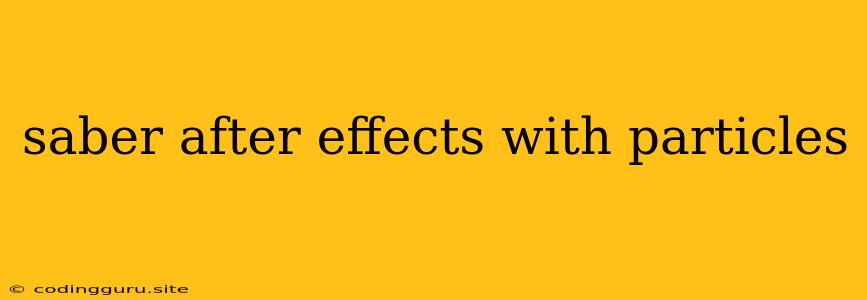Unlocking the Power of Sabers with After Effects Particles: A Beginner's Guide
Have you ever dreamt of creating breathtaking lightsaber effects in After Effects? The possibilities are endless, from the iconic blue glow of Luke Skywalker's lightsaber to the fierce crimson blade of Darth Vader. While it may seem intimidating, mastering the art of creating sabers with After Effects particles is achievable with a little guidance. This article will serve as your starting point, empowering you to bring your lightsaber visions to life.
Why Choose Particles for Your Sabers?
You might ask, why particles? Well, they offer a level of flexibility and visual control that's hard to beat when crafting dynamic, light-based effects like sabers. With particles, you can create:
- Realistic Glow: Simulate the intense, radiant energy of a lightsaber by controlling the size, shape, and color of individual particles.
- Dynamic Movement: Capture the captivating fluidity of a lightsaber's movement with particle trails and animations.
- Blending Effects: Achieve the illusion of a lightsaber cutting through objects by using particle blending modes to create convincing "burning" effects.
- Intriguing Variations: Experiment with different particle types, like points, circles, and even 3D objects, to achieve unique and stunning lightsaber designs.
Essential Tools: Setting the Stage for Your Saber Creation
Before diving into the creative process, you'll need the right tools:
- Adobe After Effects: This industry-standard software provides the environment to create your particle effects.
- Particle Systems: Explore the various particle systems available within After Effects. CC Particle World, Trapcode Particular, and Element 3D are popular choices, each offering its own strengths.
- Image Assets: Consider having images or textures for your lightsaber blade, hilt, and surrounding environment to enhance the realism.
- Creative Inspiration: Study real-world light effects and lightsaber designs from movies, TV shows, and other media for inspiration.
Building the Foundation: A Step-by-Step Guide
Now, let's break down the process of creating a lightsaber effect using particles:
-
Start with a Solid: Create a solid layer in After Effects, which will serve as the canvas for your saber.
-
Particle System Selection: Choose a particle system that aligns with your vision. For example, if you want a smooth, flowing lightsaber, CC Particle World might be a great choice.
-
Particle Emitter: Set up a particle emitter to release particles. This could be a point, a line, or even a shape that resembles the hilt of your lightsaber.
-
Particle Properties: Tweak the properties of your particles, including size, color, lifetime, and speed, to create the desired glow and movement.
-
Animation and Movement: Use keyframes and expressions to animate your particles, simulating the motion of a lightsaber.
-
Blending Modes and Lighting: Experiment with blending modes to achieve the desired look for your lightsaber. Add lighting effects to enhance the illusion of intense heat and energy.
-
Refinement and Polish: Continue adjusting the particle properties, animation, and lighting until you achieve a visually captivating and realistic lightsaber.
Unleashing Your Creativity: Tips and Techniques
Here are some additional tips to refine your lightsaber particle effects:
- Color Gradients: Create dynamic, multi-colored sabers by using color gradients within your particle system.
- Sound Effects: Integrate sound effects that align with the lightsaber's movement, such as the hum of energy or the whooshing sound of a blade.
- Particle Trails: Use particle trails to create streaks of light, highlighting the movement of the saber.
- Camera Effects: Use camera shake or motion blur to enhance the realism of the lightsaber's movement.
- Real-World Inspiration: Study footage of real-world light effects, such as lightning, fireworks, or even welding torches, to gather inspiration for your particle settings.
Beyond the Basic: Advanced Techniques
For those seeking to push the boundaries of lightsaber creation, here are some advanced techniques:
- Custom Particle Shapes: Create custom shapes for your particles using Adobe Illustrator or other vector graphics programs.
- 3D Particle Systems: Experiment with 3D particle systems like Element 3D to create more immersive and complex lightsaber effects.
- Force Field Effects: Simulate the energy of a lightsaber with particle systems by creating swirling or pulsating force fields.
Putting It All Together: Examples of Awesome Sabers
- Classic Blue Saber: A simple yet effective lightsaber effect with a smooth, blue particle trail and a bright glow.
- Dual-Wielding Sabers: Create an epic scene with two sabers spinning and clashing, using different particle colors for each blade.
- Realistic Lightsaber Duel: Use advanced techniques like particle trails, blending modes, and camera effects to create a captivating lightsaber duel.
- Custom Lightsaber Designs: Let your creativity shine by designing unique lightsaber shapes and colors, exploring different particle systems and blending modes.
Conclusion
The power of After Effects particles opens up a world of possibilities for creating mesmerizing lightsaber effects. With the knowledge and techniques shared in this guide, you'll be well-equipped to transform your cinematic visions into reality. Experiment, refine, and unleash your imagination to create unique and captivating lightsaber experiences.
